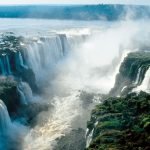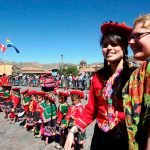This article was posted on Wednesday, May 22nd, 2019 at 8:30 pm and is filed under Cusco Tours, Tours of Peru.
Machu Picchu, always Machu Picchu. On foot, on the train and on the bus, on the train and walking or trekking through the Inca Trail … The important thing is to arrive and live to the maximum every moment, feeling the energy that surrounds you and revives when there is rain, fog or blazing sun. Happens all the time. It happens day after day.
And today, there are several ways to reach this space of harmony, but that was not always the case. For centuries it was hidden from the eyes of the world. Abandoned, the voracious nature upholstered its stone enclosures of greenery, while the rumors of a fabulous city lost in the Urubamba valley, stung the curiosity of adventurers and curious, researchers and archaeologists.

Many had heard of her in Cusco, even, her name appeared on some old maps, but who knew her? Maybe some farmers from the haciendas of the valley who did not value its importance or wanted it to be kept hidden. In 1911, these rumors were heard by Yale University professor Hiram Bingham, who was in the ancient Inca capital preparing his second expedition.
Before, it had arrived at Choquequirao believing that it was the last refuge of Manco Inca, the rebellious Inca. When he discover it (Choquequirao) he concluded that that was not the lost city of the Incas. He decided to keep looking. That’s why he would return with the intention of going to Vitcos and Vilcabamba, but while he was opening up in the city, several voices told him about another place that was beyond Mandor Pampa, at the end of the so-called Sacred Valley.

And Bingham listened, thought and decided: he would explore that area. It was right On July 24, 1911 – it was not a good day, it was a day of mud and fog – his life would change. He would explore Machu Picchu (Old Mountain in Spanish) with Peruvians Melchor Arteaga and Sergeant Carrasco. At that time, none could imagine that this place would become one of the 7 Wonders of the Modern World.
Historical and Natural Wonder

A wonder that remained hidden from the second half of the sixteenth century. A wonder rediscovered by a bold university professor. A cosmopolitan wonder, visited by thousands of travelers who today explore its terraces, its temples (the Sun, the Three Windows, also that of the Condor), its fountains, water channels and its urban sector, where the famous Intihuatana stands out.
Mythical, enigmatic, energetic. Here the Incas studied the movements of their father and their God, the Inti (Sun) which, in a figurative sense, was tied in that 66-centimeter stake that crowns a sculptural set of carved stone. Observing the shadows, they could ‘read’ the time and, through other procedures, determine the seasonal changes. Information vital for agriculture.

Some stairs lead to the Intihuatana. You have to climb them, step by step you have to climb their irregular and narrow steps. Already in the place, the visitors approach their hands to the stone that tied to the sun so that always it returned to the Andean heights. Thus they are charged with the energy that emanates from this space. Myth or Reality. Only by being there will you be able to verify it.
Yes, to be here after walking four days on the Inca Trail, watching the sunrise from the Inti Punku. Yes, arrive by train to the Machu Picchu Pueblo station to ascend by bus or with your own steps. Yes, venture by road to Santa Teresa and from there to make a pilgrimage to the cultural, archaeological and tourist icon of a nation that treasures the historical legacy of important pre-Hispanic civilizations.

It does not matter the way. The important thing is to get to the Lost City. A bastion of archeology, but also of biodiversity. Lifetime. Flora and fauna. Refuge of nature, with orchids and alders, with spectacled bears and roosters of the rocks, with white and queñuales cedars (an Andean tree), with foxes and pumas.
More reasons to include the Historical Sanctuary of Machu Pucchu in the itinerary of your first Peruvian vacations.
To consider
Machu Picchu: Due to its importance as a tourist destination, the entrance to the Inca jewel is limited. It is necessary to purchase tickets in advance. Keep it in mind so you can enjoy your trip.
Rails: The railway is the main means of transportation to reach the Lost City. At present there are several services that are offered at different times.
On foot: The Inca Trail to Machu Picchu is one of the most famous trekking routes in the world. The route begins in Piscacucho (km 82 of the Cusco-Machu Picchu Pueblo railroad) and the distance to travel exceeds 40 kilometers. Duration: 4 days.
Huayna Picchu: Climbing the Young Mountain (seen in the classic photo of Machu Picchu) is a challenge for travelers. If you want to live an extra dose of adrenaline, encourage yourself to conquer it.
The Origin: Machu Picchu would have been built in the fifteenth century by orders of Pachacutes
Manco Inca: It was a rebellious Inca that faced the Spanish conquerors. Unable to liberate Cusco, he would take refuge in the Vilcabamba Valley. He would be murdered in 1544.
Expedition: After knowing Machu Picchu, Bingham continued with his plans, reaching Vitcos and Vilcabamba. However, the rediscovery of Machu Picchu would give it fame and worldwide recognition.
Before Bingham: It is believed that in 1902, Agustín Lizárraga, who worked in the area, would take three locals from Cusco to Machu Picchu, Gabino Sánchez, Enrique Palma and Justo Ochoa.
Busy: When Bingham arrived at Machu Picchu he found two families in the area: the Recharte and the Álvarez. They planted corn on the platforms. The child Pablo Recharte, would have taken the American to the urban area of the archaeological complex.
#Cusco #MachuPicchu #CustoTours #NaturalWonder #Choquequirao







